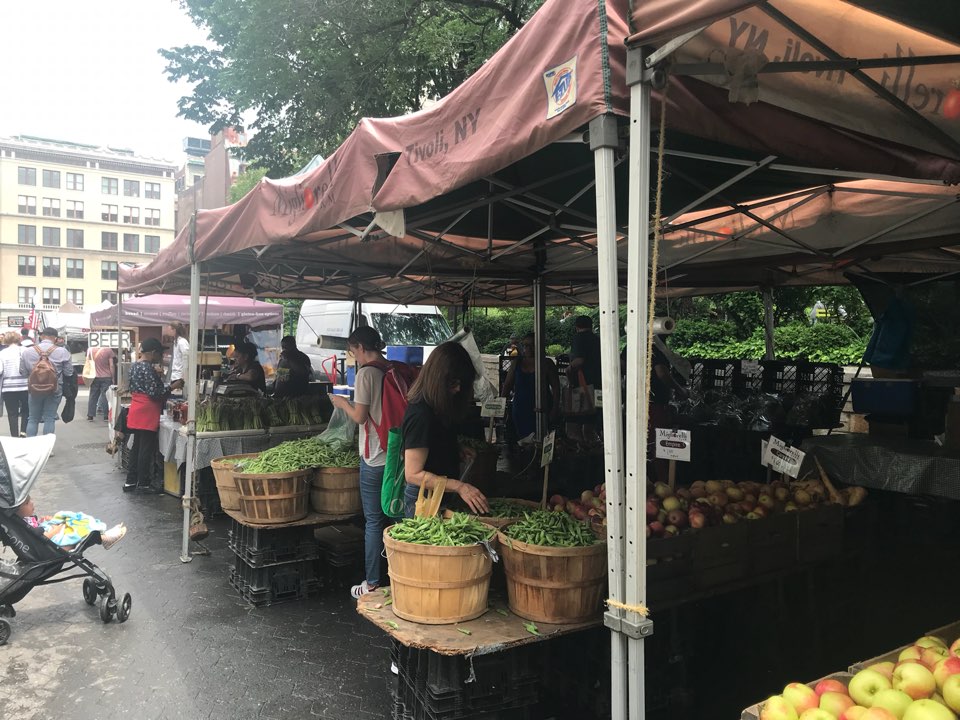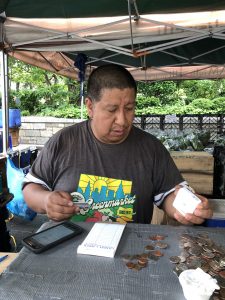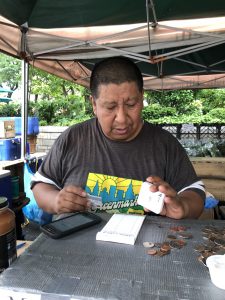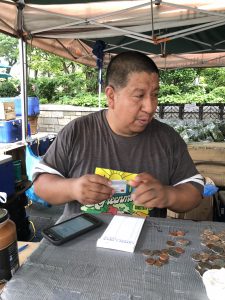Keeping a Notebook – Journal
As part of our project, we were informed to keep a notebook to journal our thoughts, ideas, or observations for a week.
Bridge 1 – Research Process
As we observed the Migliorelli market in Union Square Park, we had also interviewed the man who owned the market about his personal life. My partner and I had recorded our informal interview with the man as well. The recording is inserted below.
Bridge 1 Final Essay
Yuri Kawada
June 8, 2018
“Hero” for One Day
Farmers and greengrocers bargaining with the customers from market to market, and varying accents of English spoken amongst family and friends – Union Square Park. Conserving a unique culture, a middle-aged man caught my attention. He wore a vintage-brown oversized t-shirt that came down to his elbow. “$1.25!”, the man announced across the Migliorelli Market. The market consisted of organic fruits and vegetables – asparagus, tomatoes, apples, carrots, and cabbage. The baskets filled with fruits and vegetables convinced his customers – that is, the products are healthy and organic. Observing from afar, the man is a vendor, farmer, husband, and father.
The man had broad-muscular shoulders that were clearly visible from the exposed skin due to the humidity from the heated weather. His farmers tan was distinctly revealed behind his neck. Additionally, his tanned skin demonstrates the man’s stamina of withstanding the humid, searing weather. The market banner marked “Tivoli, NY” indicates the farm’s – upstate New York. Through this interpretation, I can deduce that the man is from Tivoli, New York (upstate), as well as his short, patchy hair, recognizes the numerous hours of farming in the broiling weather at his hometown. Moreover, the tent supporting a shelter for his goods prove that the market is only temporary for a limited amount of time. The grown beard on his chin and the solemn, focused expression on his face in the direction of the scattered coins on the counter suggests that he is experienced enough to know what to do and prioritizes more on his economy or possibly his family than himself.
Although he may be interpreted as ‘The Farm Owner’ of the Migliorelli Market, he is also the husband and father of a family. The ring worn on his fourth finger symbolizes marriage. Likewise, the woman cashier had asked whether the man had texted his daughter Jane. The man replied with a yes. Listening to the conversation between the man and the woman, I can also conclude that the woman at the cashier is his wife. Paying a visit to the farmers market at noon and afternoon around 5 p.m., the man was still working as a cashier. The number of hardworking hours did not stop his lively voice. His persistent yelling,“$1.25 for two!”, reveals his desperate motive and goal to sell his fruit and vegetable to the best of his abilities as a vendor. Similarly, his hard work and patience appeared to pay off as more customers began to check out his market. As the last part of my observational research, my partner and I bought an asparagus from the market to get a closer observation of the man. When we had approached him, he had a fixed facial expression of seriousness and rarely shown his smile to his customers. On top of his facial expression, the scar mark on his face identifies his fervent passion towards his job and well-experienced as a farmer. When we had inquired a few questions about his personal life, he had replied with thoughtful answers. With confidence, the man had introduced his wife and informed us that they had always worked at the farmers market together. This indicates his deep affection for his wife and family.
To a large extent, the man can be inferred as a hardworking farmer who takes each customer solemnly with content and pleasure for his family. The priority of his family always comes first before himself, which is evident from the conversation with his wife and the ring representing marriage. Though the interpretations from a man’s exterior appearance cannot be enough to know the truth behind the man’s motive, his identity as a diligent farmer, father, and a husband can undoubtedly be seen from the observational research – a hero.
Bridge 1 Reflection
What did you learn by completing this assignment?
By completing this assignment, I learned how observation and interpretation can be another form of source and research, which helped me be creative in this assignment. Additionally, stereotyping is one of the minor issues we have today. Hence, it was difficult at first, however, I was able to overcome the common issue of stereotyping or assuming the “hero” that I had observed into the social norm that exists in today’s society in my Bridge 1 essay.
What did you accomplish particularly well?
From my Bridge 1 essay, I think I satisfied describing the man as a father, husband, farmer, and a hero. Using abstract and concrete words, I was able to describe my observations with clear, sensory description, which I thought strengthened my essay overall.
What could you have done better, and how might you apply this to future writing assignments?
Subsequent to my Bridge 1 essay, I could have possibly added more detailed observations of the conversation between the man and woman. For the future writing assignments, I will strengthen the essay even more by incorporating additional details that help the reader get a better understanding of the figure, story, or background.
How might your thinking in Seminar have influenced your studio work?
The readings in Seminar have changed the perspective that I have had in my studio work. I think that the many readings our professor assigned us has helped our way of interpreting from our observations (such as Keeping a Notebook by Joan Didion). Keeping a notebook for a week has helped me to become a better observer of the people in a different path of interpretations.








